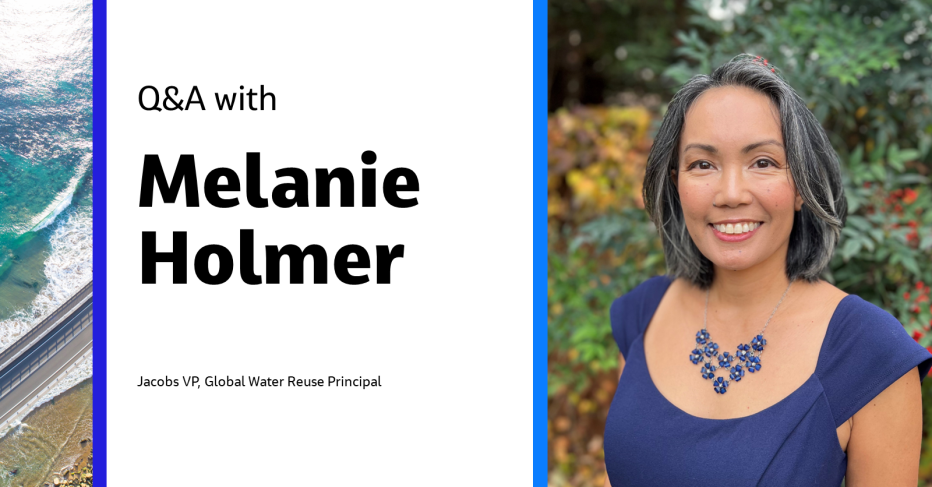
Strengthening Jacobs’ capabilities in water reuse practices and advanced treatment technologies, Melanie Holmer joins us as Global Water Reuse Principal and Vice President.
As water scarcity and impacts from climate challenge intensify, the need for reliable water supplies is increasing worldwide. In response, more communities are choosing to adopt water reuse practices and embrace the OneWater principle that all water has value. Advanced treatment technologies allow water utilities to cost-effectively reclaim and repurpose wastewater as a high-quality, resilient water supply – and increasingly for drinking water purposes.
Jacobs has been at the forefront of water reuse for decades, beginning in the 1960s with the first ever application of advanced wastewater treatment techniques in the western U.S. The key to our longstanding leadership? Our talented global team of water professionals that support our clients every day with innovative solutions.
In this Q&A, we connect with one of the newest members of our team, Melanie Holmer for her thoughts on the trends and technologies advancing water reuse today:
What are the biggest opportunities ahead for potable reuse projects?
Several states have recently adopted or are in the process of enacting direct potable reuse (DPR) regulations, including Colorado, Arizona, Florida and California, which just adopted DPR regulations on December 19, 2023. These regulations facilitate planning for DPR scenarios because the requirements are known – utilities and communities can better plan for the treatment technologies and new management and administrative requirements. DPR projects can increase a community’s water resiliency in the face of climate change and discharge limitations while also leveraging existing drinking water infrastructure.
There are opportunities to make the most of every drop of water, through higher recovery in reverse osmosis or alternative treatment trains in areas where reverse osmosis is not an option. Advances in online analyzers would greatly improve and facilitate monitoring for advanced treatment facilities.
What barriers do you see that keep these types of projects from being implemented?
The technology exists to develop safe potable reuse projects that are protective of public health and the environment, and innovations in these technologies continue. However, public acceptance has always been a major barrier to implementation of these projects. Utilities are encouraged to engage the public early and often, providing educational opportunities and forums to promote dialogue. Often, once community members understand the high level of advanced treatment associated with potable reuse, they are more comfortable with considering it as a part of future solutions.
Funding can be a challenge as well – fortunately, there are a number of federal and state programs that provide critical funding to support these projects. At the federal level, there are funding opportunities for water reuse projects from the Clean Water State Revolving Fund, Drinking Water State Revolving Fund, Water Infrastructure Finance and Innovation Act (WIFIA) Program, and Title XVI Water Reclamation and Reuse.
Are people’s attitudes changing toward potable reuse?
As communities experience the impacts of climate change and recognize that water is a limited resource, public opinions on potable reuse are also shifting. Much of this is due to educational and public engagement efforts by utilities seeking to implement these projects. Twenty-five years ago, there was strong opposition to potable reuse projects in Southern California – today, some of the largest potable reuse projects in the world are being built and planned there with the support of the public, even celebrated in news articles and television broadcasts, as communities grow to understand the importance of reusing this precious resource. The importance of education, tours, and engagement cannot be understated.
Several years ago, I visited an advanced treatment facility with a public information officer of a utility that was exploring potable reuse. He swore he could not be convinced to drink the purified water from the facility. By the end of the tour, after seeing the extensive advanced treatment processes at work, he drank the water. After that tour, he visited several others without me and he excitedly shared with me which purified water he liked best out of all those facilities. He was transformed from a skeptic into a champion of potable reuse from these tours and educational events.
Will we see direct potable reuse projects increase in U.S. in the future?
There are several DPR projects currently being planned in several states, empowered by certainty in DPR regulations, and we do expect these types of projects to increase. Indirect potable reuse projects, which leverage an environmental buffer such as a reservoir or groundwater basin, have been successfully implemented for decades in the U.S. However, some locations do not have a suitable groundwater basin for recharge or a reservoir for augmenting supply. In these instances, DPR becomes an important option to allow communities to utilize this resource instead of or before disposing of it.
How will data and technology change how we deliver water reuse solutions going forward?
Data can have the power to inform more effective solutions. Modeling coupled with robust analytical data can assist utilities in better understanding what is needed to meet regulatory compliance and increase water supply resiliency in cost effective ways. But it also has the power to inform solutions that help meet multiple objectives, such as workforce development, equity and environmental justice. As technologies continue to develop and improve, our industry should be prepared implement current solutions that allow for integration of future innovations. Near real-time monitoring for pathogens is far from ready but would greatly enhance operations of potable reuse projects. With the recently adopted California DPR regulations, there are opportunities to consider alternatives to the required treatment train that could meet site-specific needs of utilities. Jacobs is researching processes downstream of reverse osmosis that could serve as alternatives to ozone-biologically active filtration within the treatment train.
Can you tell us about any cool collaborations demonstrating OneWater through reuse?
The City of Los Angeles is embracing a OneWater approach for increasing water resiliency and building a local supply of water. The Los Angeles Department of Water and Power (LADWP), Los Angeles Sanitation and Environment (LASAN), and Los Angeles Department of Public Works Bureau of Engineering (BOE) have partnered to develop the Donald C. Tillman Advanced Water Purification Facility project. Treated wastewater from DC Tillman will be further treated with low pressure membranes, reverse osmosis, and ultraviolet advanced oxidation processes to produce up to 30 million gallons per day of purified water that will recharge groundwater basins. In recognizing the value of this wastewater as a solution to increase water supply resiliency, these three agencies are developing the city’s largest reuse project to date, and collaborating in a way they may not have traditionally engaged in the past.
What drew you to join #OurJacobs team?
I started my career with Jacobs in 1998 until 2002, and I loved the culture and approach to supporting clients with their water challenges. Twenty-one years later, after having worked at other firms, I found myself drawn to the culture once again, to the types of projects that have positive and enduring impacts on communities, and to the people that are still here that I worked with when I first started my career. The culture of caring, the embracing of diversity and inclusion and the commitment to aim higher and to do things right are just part of what drew me back to Jacobs, and I truly feel that I am back home.
About the interviewee

Melanie Holmer recently joined Jacobs as Global Water Reuse Principal and Vice President.
An environmental engineer with more than 25 years’ experience, Melanie specializes in strategic planning, process selection, detailed design, program management and technical direction in drinking water, wastewater and water reuse. She’s a recognized leader in potable reuse and advanced treatment technologies, having focused most of the past decade on providing subject matter expertise for major potable reuse projects as well as providing advanced treatment regulatory and policy development and research, including pilot and full-scale trials to support diverse water supply strategies.
She’s a member of several industry organizations such as the WateReuse Symposium Technical Committee (Vice-Chair 2024 Symposium); WateReuse California Board of Trustees; American Water Works Association Reuse Committee; Journal of American Water Works Association Advisory Board and Water Reuse Column Coordinator.
Melanie’s passion for water carries outside of work into her favorite activity, scuba diving. She also enjoys traveling, hiking, golfing and loves to sing, play guitar and ukulele.
You might be interested in...
Join #OurJacobs team
What drives you drives us as we work to build a better world – together. At Jacobs, every day is an opportunity to make the world better, more connected, more sustainable. We’re always looking for dynamic and engaged people to join our team. Bring your passion, your ingenuity and your vision.














































